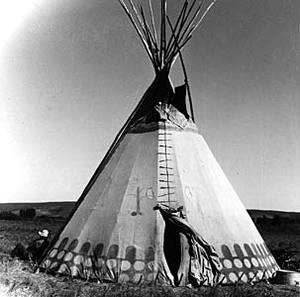

Summer is drawing to a close and your kids will soon be in school (if they’re not already). But the warm weather continues in some places and there is still time to launch an outdoor project or two with the geeklets. Any project that will give you an excuse to get outside with the young ones is a good one.
Build a Tipi
I have fond memories of the forts we used to build (who doesn’t?). But if I remember correctly, our structures were about as good as the lousy materials we used. If you were a scout, you probably got a bit more detailed in your builds, then, if you’re like Steve Norris of Ontario, you built this. For our needs though I decided to take my cues from the original shelter builder experts themselves – the Plains Indians – and institute a bit of a history lesson with the geeklets in the process. More after the jump.
The tipi really is genius in its simplicity. Plus, it is a boatload of fun to build and to play with. Many of the links and plans you find out there for guidance have collected and/or derived and repeated the same instructions – namely from the 1945 book Wildwood Wisdom by
Ellsworth Jaeger. My favorite guide is an early edition of the Outdoorsman’s Handbook by Clyde Ormand, the only outdoors guide you will ever need that also contains instructions for a traditional wigwam (next time). But while all of these are good, they do have you building a 10 to 15 feet structure that houses your whole Indian family complete with smoke flaps for your campfire.
Sounds like fun until you realize that the materials at your disposal don’t measure up. For our build, we used 10 to 12 1"x1" molding strips in 10′ lengths from the local building supply store. The cover was simple unprimed cotton duck canvas bought in bulk on eBay. The trick now was to build a structure that measured up to these supplies. Most canvas you can buy will come in rolls either 52 or 60 inches wide—definitely not wide enough for a worthy structure. The wrap must be twice as long as wide so we applied some Plains Indian skills and laced two pieces together to create a 7.5 x 15 feet wrap. Three 10-foot poles were tied off at the 3-feet mark to form a tripod. The last seven or eight poles were leaned into the joint at regular intervals, leaving one with more space for the opening. The whole thing was wrapped and tied in simple fashion at the joint with manila rope. We now had the framework for a 7′ tipi, plenty tall and wide enough for your average ten-year-old and below.

Decorating our tipi cover was another matter. I suddenly realized that building the tipi was just an excuse for a group art project. Some old paint in the basement plus some "oops" paint from Home Depot ($1 a pint!) became the tools of a fun hour splattering, smearing, sliding, and tossing. The Plains Indians never did anything like this. Behold:
"Le Tipi Moderne."

Of course, no build like this would be complete without a history lesson. You can bone-up on your Native American history at
Americanindian.com or get some interesting stats and info at Wikipedia.
For more hints and tips, the folks over at Inquiry.net have a boat load of links taken from the classic 1908 Scouting for Boys by Robert
Baden-Powell, and is certainly a stew pot of ideas for the adventurous geekdad.
![Reblog this post [with Zemanta]](http://img.zemanta.com/reblog_e.png?x-id=67c0102e-8758-4620-adc8-5f2b8e599d65)

